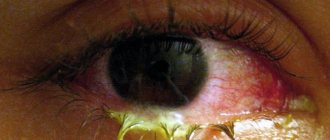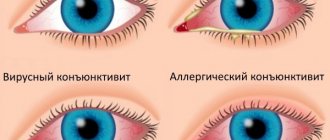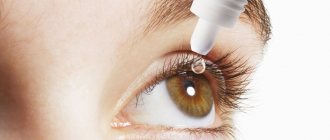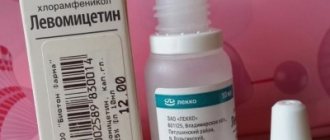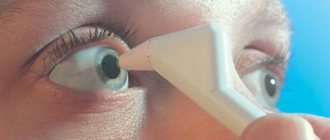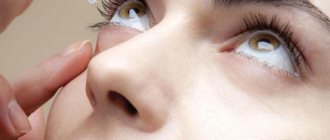Conjunctivitis is treated with medications. It is impossible to get rid of this disease with folk remedies, whatever the nature of its occurrence - bacterial, viral, allergic. Rinse solutions are also used in the treatment of this disease. Let's find out how and with what you can wash your eyes with conjunctivitis.
In this article
- What causes conjunctivitis and how does it manifest?
- Do I need to treat my eyes for bacterial conjunctivitis?
- Eye treatment for viral conjunctivitis
- How to wash eyes with allergic conjunctivitis?
- Is it possible to wash your eyes with saline solution for conjunctivitis?
- How to wash your eyes with conjunctivitis?
Inflammation of the conjunctiva is a common disease that 70% of the world's population suffers or has suffered from at least once in their lives. Conjunctivitis should always be treated under the supervision of a doctor and with the use of medications. However, not all people follow this simple rule when trying to eliminate the symptoms of the disease with folk remedies or rinsing solutions alone. They can be used in the treatment of conjunctivitis, but should not be an alternative to medications.
This may cause complications. In the most severe cases, the disease leads to severe deterioration of vision and even complete loss. At the same time, conjunctivitis cannot be called a very dangerous pathology. Let's look at its features and find out what to wash your eyes with and how to do it.
What causes conjunctivitis and how does it manifest?
The inflammatory process on the connective membrane can develop for a variety of reasons. Viruses, bacteria, fungi, cosmetics, household chemicals, and contact lens solution can provoke it. Often conjunctivitis is a consequence of chronic allergies to pollen, medications, and food. The culprit of the disease can be a common injury to the eyeball. There are many factors contributing to the development of this pathology. The causes of conjunctivitis determine the course of its development, form of occurrence, and symptoms.
We list the general signs of this disease:
- itching and burning in the eyes;
- dryness of the cornea and uncontrolled lacrimation caused by it;
- sensation of the presence of a foreign body on the surface of the eyeball;
- increased sensitivity to light;
- redness of the conjunctiva and eyelids;
- swelling;
- mucous and/or purulent discharge;
- formation of follicles or films on the mucous membrane of the eye;
- rashes on the eyelids, blisters.
Some types of conjunctivitis also cause symptoms that are not related to the visual organs:
- increased body temperature;
- cough and runny nose;
- inflammation of the lymph nodes;
- weakness and drowsiness, loss of appetite;
- headache;
- sore throat.
The listed symptoms are not observed with every type of conjunctivitis. They should be considered separately. Based on the nature of the disease, you can determine what you can wash your eyes with, how to do it correctly and with what frequency.
What is included in the antiseptic for COVID-19
While chlorine-based disinfectants are most often used to disinfect work surfaces, only alcohol-based preparations are suitable for treating skin:
- isopropyl alcohol 70%;
- ethyl alcohol 75%
These antiseptics cannot be used before two months of age, since the skin of newborns absorbs alcohol and provokes systemic interaction with the drug. The use of antiseptics is also limited for open wounds on the surface of the skin.
Antiseptics for coronavirus have pros and cons. The advantages include:
- lack of microbial resistance to them;
- the presence of glycerin in the composition, which prevents drying of the skin of the hands;
- Rare allergies to alcohol solutions.
There are fewer disadvantages: the risk of easy inflammation and skin irritation if its integrity is violated.
Do I need to treat my eyes for bacterial conjunctivitis?
With bacterial inflammation, purulent exudate is always released. At first, there is usually mucus on the conjunctiva, but after a day or two, pus also appears. Moreover, a lot of it is formed. It contains a large number of bacteria - gonococci, streptococci, pneumococci, etc. They actively multiply, which often leads to infection of the second eye, although the disease begins in one. Bacterial conjunctivitis always occurs in an acute form. It begins suddenly and literally within a day almost all the symptoms of the disease appear. The patient's eyes are very itchy, lacrimation and blepharospasm develop, the eyelids and conjunctiva turn red and swell.
This type of inflammatory process is treated with antibacterial medications - drops and ointments. Antibiotics are also prescribed. Regardless of what bacterium caused the inflammation, rinsing solutions are always used. The pus causes the eyelids to stick together. Crusts form on their edges. They are removed using special antiseptic agents from which solutions are made. It is not recommended to carry out this procedure using ordinary water. Firstly, it does not fight germs. Secondly, it may contain other microorganisms that are dangerous to the organs of vision.
How to wash your eyes with conjunctivitis caused by streptococci, pneumococci, Pseudomonas aeruginosa, etc.? Furacilin is almost always prescribed. It has no contraindications and is used to treat children and adults. This drug has antiseptic properties. It allows you to suppress the growth of bacteria. This is not the most powerful remedy, but it is harmless and quite effective. However, it is worth understanding that conjunctivitis cannot be cured with eyewash alone. The basis of treatment is the instillation of antibacterial drops.
Eye treatment for viral conjunctivitis
The most common types of viral conjunctivitis are adenoviral and herpetic. The first occurs against the background of an acute adenovirus infection, which is accompanied by fever, runny nose and cough. Inflammation of the conjunctiva occurs only as a result of exposure to adenoviruses. In this case, the incubation period can last 7-10 days, after which the following symptoms appear:
- itching in the eyes;
- tearfulness;
- mucous discharge;
- slight redness of the eyelids and conjunctiva.
Adenoviral conjunctivitis rarely takes an acute form. Its symptoms are moderate. There is usually no pus. Its appearance may indicate the onset of bacterial inflammation. But you still need to wash your eyes. Furacilin is also suitable for this. It must be borne in mind that this remedy is necessary, first of all, to eliminate signs of the disease and prevent the spread of bacteria and viruses. Viral conjunctivitis is treated with antiviral drugs, which should be prescribed in the first days of the disease, otherwise they will be useless. You can prevent a bacterial infection from joining the inflammation with the help of antibacterial drops and ointments. Antibiotics are ineffective for viral infections of the body.
How to wash eyes with allergic conjunctivitis?
Let us briefly consider this type of pathology, since it is detected quite often. An allergy can occur to absolutely any substance. It depends on the functioning of the immune system. But often allergic reactions are caused by plant pollen, medications and foods. The disease develops very quickly. The first symptoms appear within a few hours after exposure to the allergen on the conjunctiva. A typical sign of an eye allergy is very severe itching. The patient is also concerned about tearing.
Allergic conjunctivitis is the only type of pathology in question that is not transmitted from person to person. Another difference is the absence of purulent discharge. Mucus is also rarely observed, only in severe cases of the disease. She is treated with antihistamines. Corticosteroids are prescribed in extreme cases as they have many side effects. Symptoms are relieved with moisturizing drops made from natural tears. They do not contain preservatives, they are used for conjunctivitis in children and adults.
As for washing the eyes, for allergic inflammation you can also prepare a solution from Furacilin. But folk remedies are also suitable - chamomile, celandine, tea leaves. There is almost no purulent and mucous discharge, so antiseptic agents can not be used unnecessarily. If there is a risk of developing bacterial conjunctivitis, then antimicrobial drops are instilled.
Is it possible to wash your eyes with saline solution for conjunctivitis?
Saline solution is the most affordable and harmless drug, which is a 0.9 percent solution of sodium chloride in sterile water. It is used for diseases of the nose and throat. It is also used to treat contact lenses. Is saline solution suitable for washing eyes for conjunctivitis? This question can be answered in the affirmative. This drug has the following effects:
- eliminates itching and burning;
- prevents the growth and reproduction of pathogenic microbes;
- provides hydration to the cornea.
There are no contraindications to using saline solution for eye treatment. It is not used only in case of individual intolerance, which is very rare. You shouldn't have high hopes for this medicine either. When treating conjunctivitis, it is necessary to influence the cause of inflammation. Saline solution can become an auxiliary agent.
What is an antiseptic and why is it needed?
Before deciding which antiseptic for coronavirus is better, let’s consider the purposes for which it is used.
An antiseptic is a disinfectant necessary for disinfecting medical instruments and maintaining hygiene in cases where it is not possible to wash your hands with soap. The product is for external use only. It varies in composition and release form (foam, spray, gel, etc.). Alcohol is often used as the active substance.
Against the backdrop of the epidemic, the demand for disinfectants has increased significantly. Due to the large assortment of sanitizers, it is quite difficult to determine which antiseptic to buy for coronavirus. In order not to make the wrong choice, it is important to know what COVID-19 is and how the disease spreads.
How to wash your eyes with conjunctivitis?
It is immediately worth noting that with conjunctivitis, both eyes should always be treated, even if the inflammation affects only one of them. Otherwise, the disease will certainly become bilateral. How often should this procedure be performed? It does not take much time, and the solutions used to treat the eyes are so harmless that the number of procedures per day is not limited. For conjunctivitis, it is better to wash your eyelids in the morning and before bed. It is also advisable to do this every time before instilling drops.
First, prepare the solution correctly. Take a Furacilin tablet, dissolve it in 100 ml of boiled water and strain, as there will be sediment. After this, wash your hands thoroughly, prepare several tampons, more cotton wool or bandage and begin the procedure:
- soak cotton wool in the solution and wipe your eyelids with it from the outer corner to the inner;
- remove crusts formed due to pus;
- then rinse the other eye using a new swab;
- You need to complete the procedure by cleaning your eyelids with cotton wool soaked in boiled cool water.
Now you can start instilling drops or applying ointments. If the patient is a schoolchild, you need to help him treat his eyelids with the solution and make sure that he does everything correctly. A very young child can wash his eyes more than 6-8 times a day, immediately after mucus or pus appears. Try to carry out the procedure as hygienically as possible.
So, you can treat your eyes with conjunctivitis with a solution of Furacilin and saline. Other remedies can also be used - black tea, chamomile decoction, aloe juice. Before using them, you should consult your doctor. As is now clear, inflammation of the conjunctiva most often occurs due to the contact of bacteria and viruses. Neither antiseptic solutions nor folk remedies can destroy these pathogens. Complex treatment will allow you to quickly get rid of the disease and prevent it from becoming latent.
Now you know how to wash your eyes with conjunctivitis and what to do with it. The nature of the disease and its duration partly depend on this procedure. On average, it is treated for 7-14 days. If the disease is neglected, it will become chronic. In addition, other eye diseases may develop against its background - blepharitis, keratoconjunctivitis, keratitis. They are accompanied by visual impairment. Do not self-medicate, but immediately contact an ophthalmologist.
Rules for using antiseptics for coronavirus
An antiseptic for coronavirus infection is needed when soap and water are not available for use, and hands need to be sanitized. First of all, it is necessary to consider what type of pathogens the drug is designed for. Many antiseptics are designed to eliminate bacteria, so for any virus, including Covid, they are simply useless. It is better to give preference to a disinfectant with a broad spectrum of action and a high alcohol content (at least 60%).
The rules of use, first of all, require familiarization with the instructions for the product, which indicate how long and in what quantity the drug is rubbed into the skin - the main point of application of antiseptic solutions. Apply the product to your hands between the fingers, rub it in until completely absorbed, for at least half a minute. If we are talking about disinfectant solutions for surface treatment, hands are usually protected with special gloves, and the treatment time is indicated in the instructions for the preparations.
We emphasize that even the most effective hand sanitizer will not help protect against coronavirus if:
- Apply it to dirty hands with remnants of protein components of various origins: the protein blocks the effect of alcohol.
- Use antiseptic wipes instead of gel or solution to treat your hands, since the amount of solution in the wipes is limited, they dry quickly.
- Do not follow the following algorithm of actions:
- 3-5 ml of solution or gel (the dirtier the hands, the more antiseptic is required) per use;
- with light movements, distribute the product over the entire surface of the hands, from the back and inside, between the fingers;
- wait until completely dry, do not wash your hands after this;
- microcracks, cuts, wounds are covered with adhesive tape.
Proper hand cleaning with an antiseptic minimizes the risk of infection, but does not completely eliminate it.
